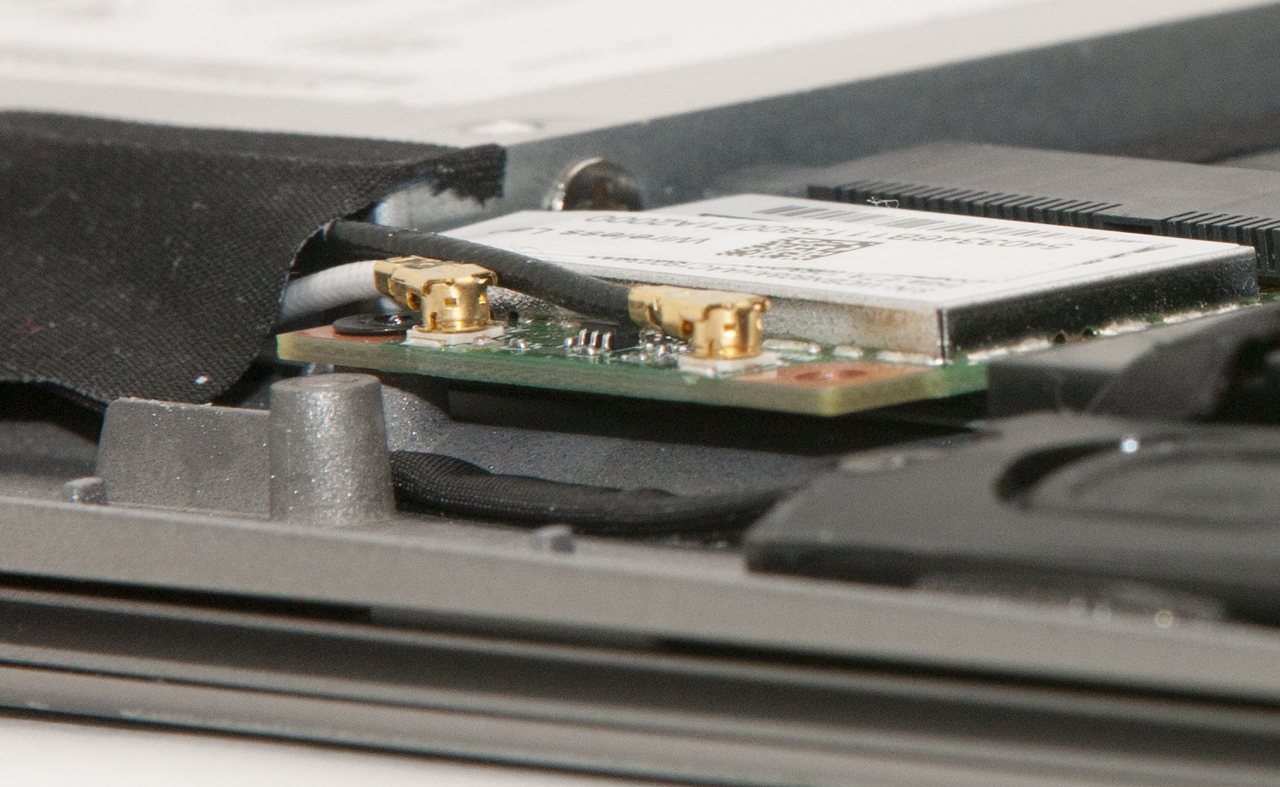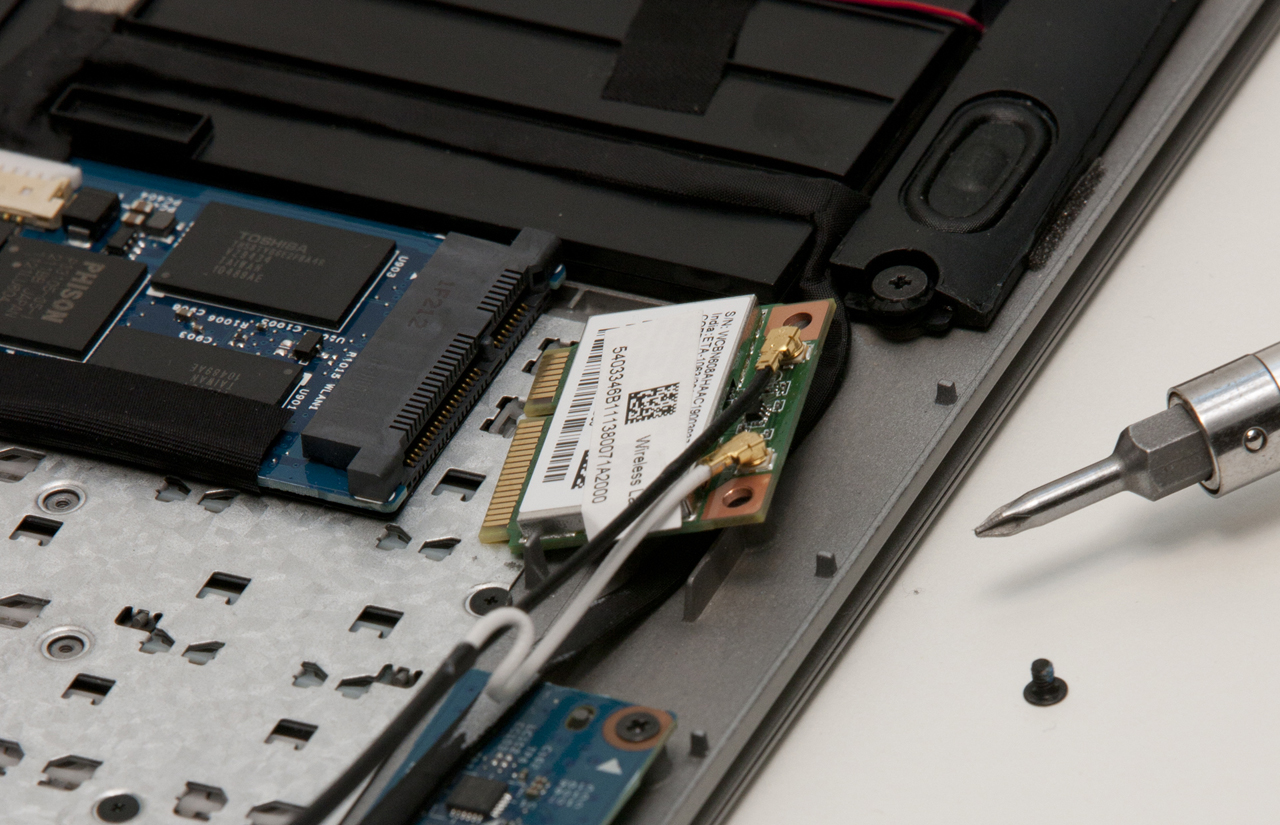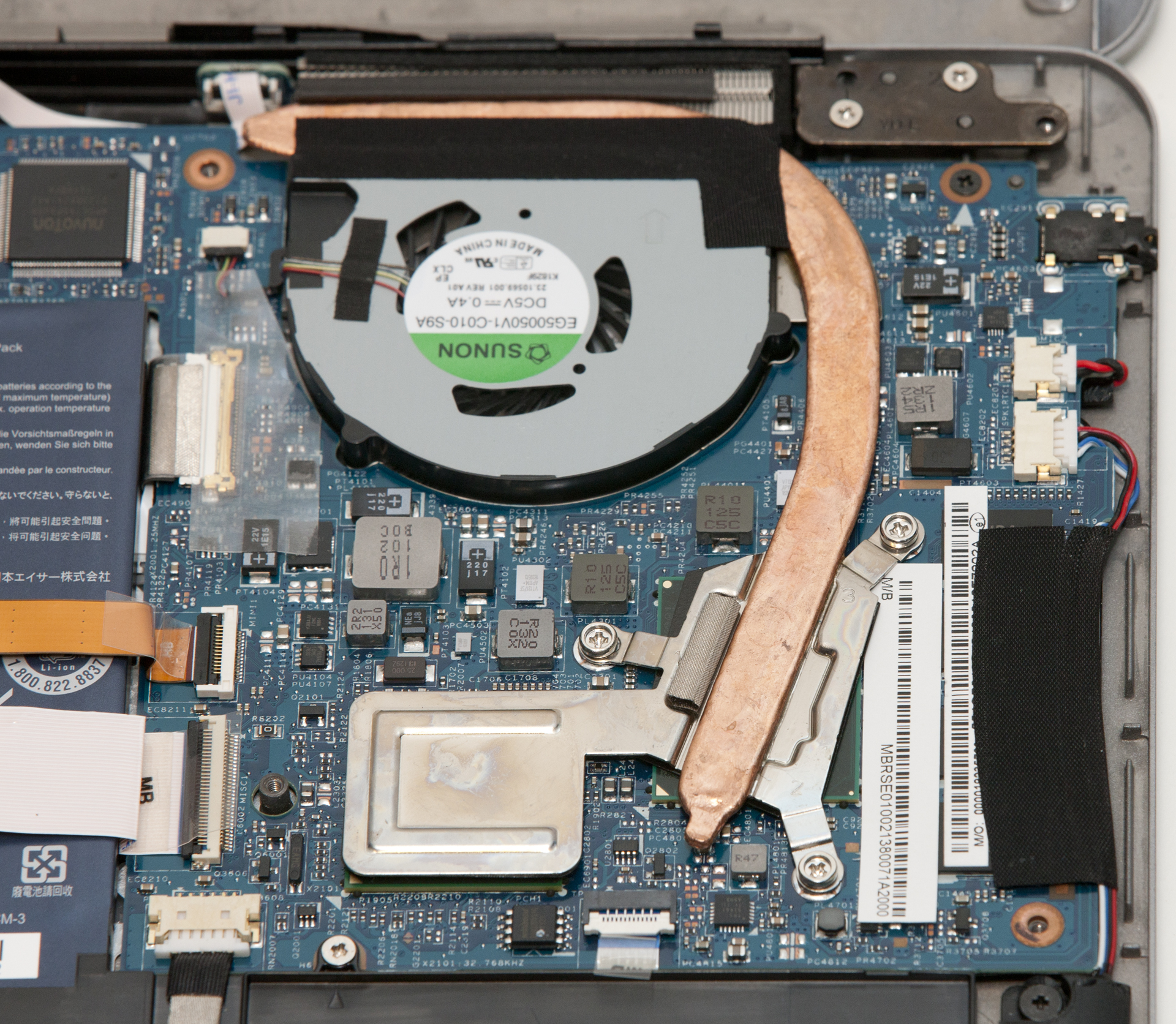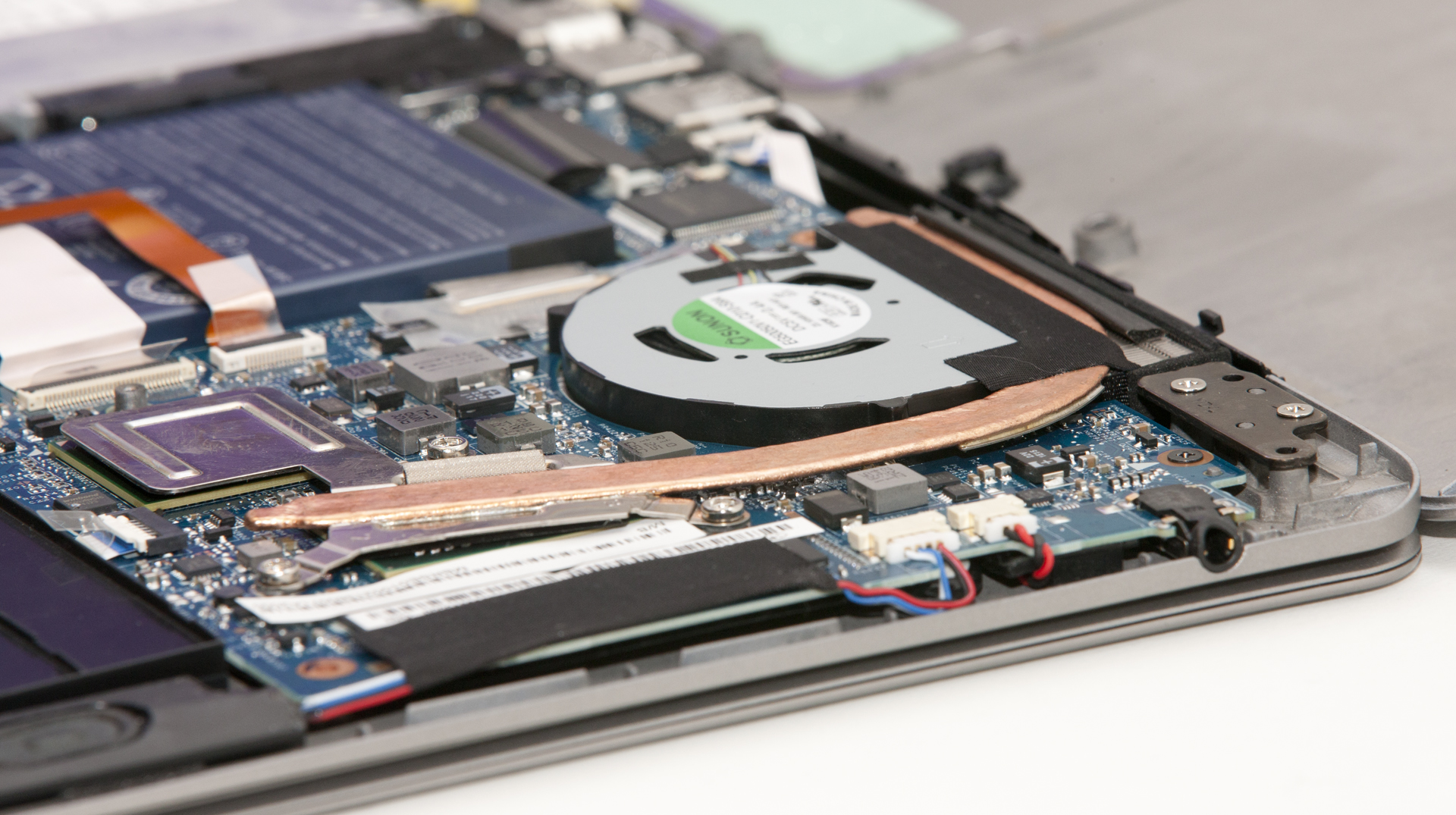Ultrabook: Behind How Intel is Remaking Mobile Computing
We recently had the opportunity to sit down with some of Intel's high-level execs responsible for the Ultrabook initiative to talk about its inception, to track its progress over a few generations, and to get an idea of where Ultrabooks are going.
Elbows-Deep In Innards, Then A Flatline
There’s nothing too out of the ordinary to report with the mini-PCIe Wi-Fi module. Its thinness plays well with the Ultrabook concept, and its antenna wires are secured well around the notebook frame. My issue here is that there are only two wires! I want the added signal quality and performance of a 3x3 Wi-Fi solution. I mean, sure, compared to many phones and tablets and low-end notebooks sporting only one antenna, this is an improvement. I can live with 2x2, but I want better.
When you’ve grown up with Zalman coolers for gaming towers, seeing a CPU heatsink that’s half the thickness of a pancake is a bit of a shock. One has to marvel at the thought that this tiny fan and bit of copper is sufficient to cool an integrated Core i5 processor. Note that there’s a four-wire cable running from the fan to the motherboard, just like on desktop systems. However, notebook cabling tends to be much smaller and flimsier than desktop parts, and it’s very easy to snap something if you’re just bungling around with needle-nosed pliers, a butter knife, or whatever tool happens to be handy. If you try to get inside one of these machines, proceed with absolute, ultra-gentle caution.
To make this point excruciatingly clear, consider how I killed this Ultrabook. It didn’t take much.
I’d been using it for a few days, so I knew it was in perfect working order. You may note in several of the above pictures that the thin Li-ion battery sits smack in the middle of the notebook, nestled in the L-shaped crook of the motherboard and adjacent to the storage drive. Now, as everyone who’s ever worked on notebooks knows, the very first thing you do before opening a notebook is unplug the power and remove the battery. But since there’s no easy way to remove the battery, and it happens to be trapped under two cables that require the opening of four fragile connectors, I sort of forgot this part.
And so it happened that I was tooling around inside the Ultrabook while the battery was still attached. My attention was elsewhere for a moment, and my screwdriver brushed over the I/O daughterboard. I saw a flash of light from my screwdriver tip. I don’t even know where on the board it touched. But that was enough. No matter how many times I checked and rechecked my connections, the little Acer was dead as a doornail—no display, no LEDs, nothing. Learn from my negligence. The battery always comes out first.
Get Tom's Hardware's best news and in-depth reviews, straight to your inbox.
Current page: Elbows-Deep In Innards, Then A Flatline
Prev Page Dissecting An Ultrabook Next Page More Pics-
techtalk I am just half way through the article. I am compelled to comment here. "What an Article" Amazingly well written, superb flow and great content.Reply -
outlw6669 Reply11271822 said:The battery always comes out first.
Words to live by.
RIP brave little Ultrabook. -
nibir2011 ReplyUltrabook aims to make its platform so compelling that, frankly, you’d be a fool to consider an under-performing, over-priced, feature-limited high-end tablet.
It will be only possible if Intel and AMD goes hand in hand. Mobile sector is so lucrative to OEM that eventually they will go there until there is a great product. If intel only thinks about their own business then it will be like what microsoft did to desktop. No software developers do not want to make consumer application, as app developing is business friendly.
It has to be a joint collaboration. -
nibir2011 ReplyUltrabook aims to make its platform so compelling that, frankly, you’d be a fool to consider an under-performing, over-priced, feature-limited high-end tablet.
It will be only possible if Intel and AMD goes hand in hand. Mobile sector is so lucrative to OEM that eventually they will go there until there is a great product. If intel only thinks about their own business then it will be like what microsoft did to desktop. No software developers do not want to make consumer application, as app developing is business friendly.
It has to be a joint collaboration. -
kartu Huge, fictional article on what is supposed to be a tech site.Reply
Everyone has a notebook. Most of them are more than fast enough.
Now what can a company that excels only at CPUs do about that?
It sure takes a genius to notice that people like lighter thinner thingies, right.
I'm sure Steve Jobbs (I guess that's The Genius to the article's author) absolutely had to take part in this astonishingly far sighted decision to go lighter and thiner, it is soo far sighted, nobody else could have imagined that.
People prefer thinner and lighter, cooler looking things... What a frucking surprise... -
williamvw Reply11274396 said:Huge, fictional article on what is supposed to be a tech site.
Fictional. I'm not sure that word means what you think it means.
11274396 said:Everyone has a notebook. Most of them are more than fast enough. Now what can a company that excels only at CPUs do about that?
That is an excellent question. You may wish to review pages 1 through 6 for answers. Pages 10 through 13 aren't bad, either. None of the content in them is fictitious, in case you remain unsure.
11274396 said:People prefer thinner and lighter, cooler looking things... What a frucking surprise...
Thank you for your input. Your skepticism is even more warranted than it is well-stated. Of course, just because people want things doesn't mean that those things actually exist. Or are affordable. Or can be serviced. I mean, at least that's the case in the real world. In fictional scenarios, where the Tooth Fairy delivers ultralight notebooks from the future, tiny companies can move product ecosystems with the same ability and effectiveness as large ones, and unicorns soar majestically through pink and purple treetops, I suppose anything is possible. In the real world, though, this article describes how things actually get done.
-
superduper Although a well written article, I still have reservations regarding some of the context:Reply
The battery life "ballooning" had very little to do with Ultrabooks but rather silicon that was more frugal, particularly at idle and the density of battery packs. Your average Ultrabook often sacrifices Li-Polymer battery capacity to remain thin and svelte (MBA an exception). As a result, the 35W notebook with the bigger battery will get better battery life than the 17W ULV (vast majority of computing is spent at idle).
The facial and speech recognition software seems very nifty, but it's still not something that's an Ultrabook specialty. The software is available to tablets and smartphones as well (the Moto X uses a specialized core specifically to handle the speech recognition).
I'm far more interested in what Intel is looking to offer in 2015 for the Ultrabook platform than I am about the rather weak software additions that don't differentiate it. What is Intel going to offer me in exchange for the extra $200-$300 dollars out of my pocket for an Ultrabook? What am I getting beside a thinner chassis to warrant that much cash? In some ways, to me it seems like Intel and its OEMs have become victims of their own success. The Ultrabook is there to revive some lost sales to the mobile market, but outside of a higher price tag and a dedicated keyboard, I don't see what the bonuses are. -
williamvw Reply11275162 said:Although a well written article, I still have reservations regarding some of the context:
The battery life "ballooning" had very little to do with Ultrabooks but rather silicon that was more frugal, particularly at idle and the density of battery packs. Your average Ultrabook often sacrifices Li-Polymer battery capacity to remain thin and svelte (MBA an exception). As a result, the 35W notebook with the bigger battery will get better battery life than the 17W ULV (vast majority of computing is spent at idle).
The facial and speech recognition software seems very nifty, but it's still not something that's an Ultrabook specialty. The software is available to tablets and smartphones as well (the Moto X uses a specialized core specifically to handle the speech recognition).
I'm far more interested in what Intel is looking to offer in 2015 for the Ultrabook platform than I am about the rather weak software additions that don't differentiate it. What is Intel going to offer me in exchange for the extra $200-$300 dollars out of my pocket for an Ultrabook? What am I getting beside a thinner chassis to warrant that much cash? In some ways, to me it seems like Intel and its OEMs have become victims of their own success. The Ultrabook is there to revive some lost sales to the mobile market, but outside of a higher price tag and a dedicated keyboard, I don't see what the bonuses are.
Excellent points, and I agree with all of them. You are absolutely correct about the battery issue. Intel has no influence that I know of over Li-Ion battery efficiency; it can only try to reduce the platform's drain on the battery that's there. That was the company's challenge: how to get every component to consume less power. Obviously, some have more leeway than others.
I also share your curiosity about 2015, as I indicated in the conclusion. It might be fair to say that if Centrino's mission was to cut the Ethernet cord, Ultrabook's (at least initial) mission is to cut the power cord. The thinner and lighter business just goes along for the ride.
To be totally honest, 2012 Ultrabooks were not enough to interest me. It wasn't different enough from what I already owned. But you have to start somewhere and implement change in stages. The first design that really grabbed me was the Yoga. The convertible thing works for me and my needs, and the design is superior to, say, a tablet wrapped in a keyboard case.
Your big question, of course, comes back to MIPS, and this is really a religious issue. Do we want our MIPS in the cloud or on our lap? There are good arguments both ways. Obviously, Intel's substantial PC group prefers them in our lap. My daily struggles with Google Voice tell me that this is a worthwhile thing. Now, if carriers improve and whatnot, and I'm able to get the same class of perceptual computing performance from the cloud on my phone that I can get on my lap in an Ultrabook, I think the weight of judgment must finally fall in the cloud's favor. It's more efficient on all counts. (I'm ignoring security concerns for the sake of argument.) But when I'm using my phone to compose notes or story chapters or whatever, which I do every day, then all I care about is accuracy, speed, and my total productivity. If the Ultrabook effort fosters a notebook ecosystem in which I can get better results for my needs from a two-pound convertible, then I'm all about the convertible and totally behind Ultrabook. I'm selfish that way.
In short, we may find that the Ultrabooks of 2015 don't offer you enough extra value to justify your extra $200 or $300. However, I'd wager that at least some of the benefits you will enjoy in your non-Ultrabook, mainstream laptop of 2015 would not exist at their then-current level of development without Intel having made the investments in Ultrabook I've described in this article.
And what if Google and Apple and whomever manage to saw Intel's legs off and leave the notebook paradigm in the dust? Well, that's how it goes. The market decides what has value and what doesn't. That trend has already started. The question now is whether it will continue.
-
williamvw Reply
Oh, my gosh -- ANOTHER accusation of bribery! How novel! Well, since you managed to deduce that much on your own, geeze, lemme think... How much did they offer to pay me? Oh, I remember! It was http://www.youtube.com/watch?v=-DJtHL3NV1o!!! Because that's how globe-spanning $115 billion companies get to $120 billion, by putting their reputations on the line and bribing little journalists like me to write articles about historical developments just like this one.11277068 said:How much did Intel pay you to write this ? , we all know that ultra books sales are below freezing





